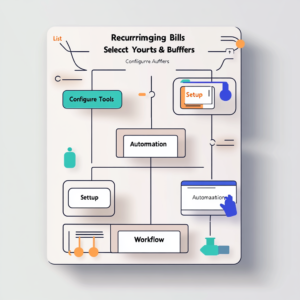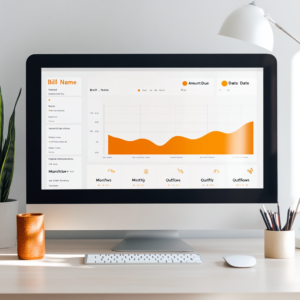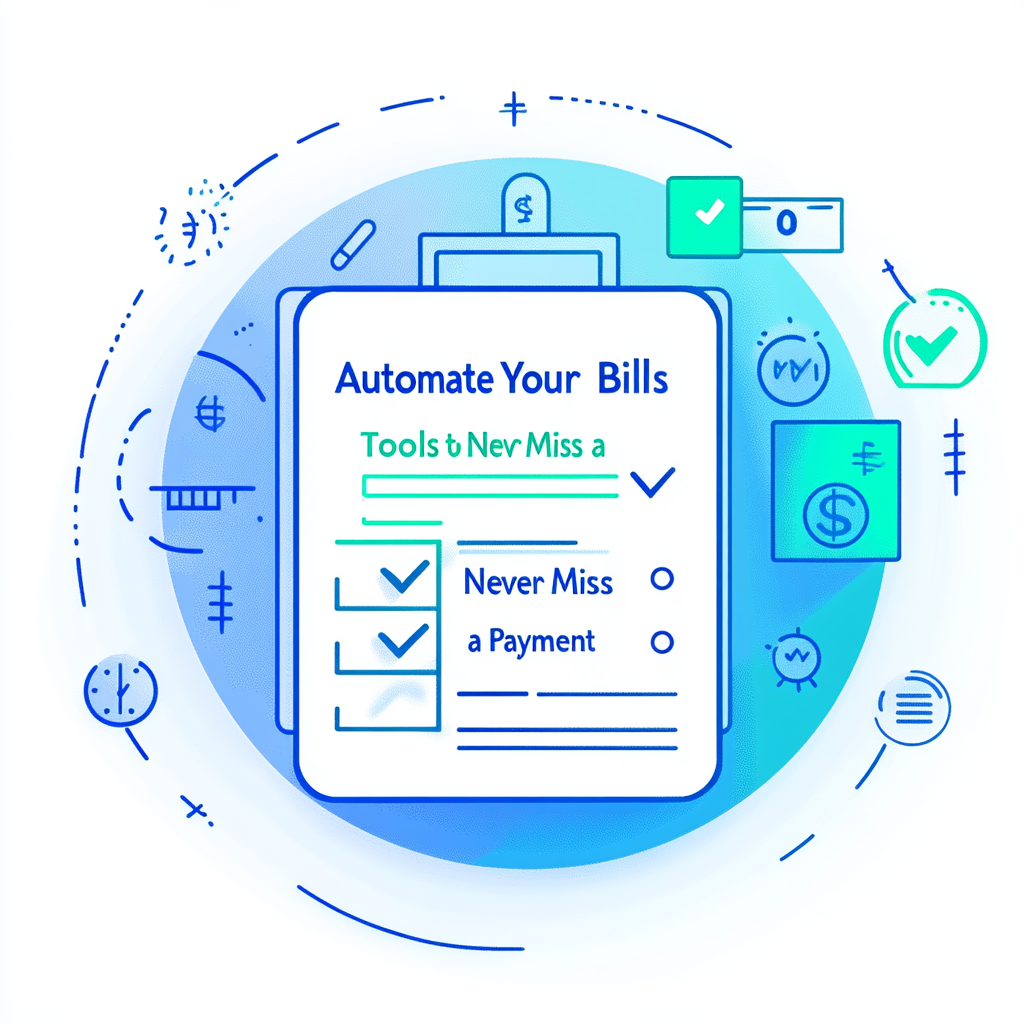1. Introduction
Managing dozens of monthly payments—rent, utilities, subscriptions, loans—can feel like a second job. Late fees, service interruptions, and credit-score damage lurk behind missed due dates. Automate Your Bills Tools transform this chore into a hands-off process: once configured, payments occur without manual intervention, backed by alerts and dashboards that keep you informed. This article explores why automation matters, how to implement it securely, and which platforms and integrations deliver the most reliability. We’ll link to our internal Emergency Fund Planning guide for setting aside reserves to cover automation hiccups, and reference an Investopedia overview of autopay best practices. By the end, you’ll possess a 360° blueprint to never miss a payment again—saving time, fees, and stress.
2. Why Automate Your Bills?
Late or forgotten payments cost Americans over $3 billion annually in fees and interest charges. Automating bills offers:
Reliability: Payments execute on schedule, eliminating human error.
Credit Health: On-time payments bolster your payment history and credit score.
Time Savings: No more logging into dozens of portals or writing checks.
Cash-Flow Clarity: Consolidated dashboards provide a real-time snapshot of outgoing obligations.
Beyond convenience, automation supports long-term financial discipline. When your essentials—mortgage, insurance, utilities—are on autopilot, you free mental bandwidth to pursue savings, investments, or side-hustle growth. Automation is not “set and forget”; it’s “set and monitor”—enabled by fail-safes that catch anomalies before they bloom into late-payment crises.
3. How Bill Automation Works
At its core, automation leverages scheduled electronic transfers: ACH debits, credit-card charges, or platform-specific APIs. Process flow:
Enrollment: You authorize a company to debit your bank account or card on a specified date each cycle.
Scheduling: The system queues payments in advance, often 2–5 days before due.
Execution & Confirmation: Upon transfer, you receive confirmation via email or app notification.
Reconciliation: Transactions appear in your bank or budgeting app; automated matching tags them as paid.
Security protocols—multi-factor authentication, tokenization, encryption—ensure sensitive data remains protected. To prevent overdrafts, many tools include a “reserve buffer” setting: hold back an extra $50–$100 in your bank account to absorb timing mismatches.
4. Top Tools for Automating Your Bills
4.1 Bank Autopay Services
Most banks offer free autopay: navigate to your biller’s payee settings in online banking, set amount and date, and enroll. Pros: no third-party fees, direct ACH. Cons: siloed per biller, limited reporting.
4.2 Personal Finance Apps
Apps like Mint and You Need a Budget (YNAB) connect via Plaid or similar to fetch bill reminders; they won’t pay directly but alert you to upcoming debits. Simplifi by Quicken offers a hybrid: automated scheduling suggestions based on cash flow, which you approve before execution.
4.3 Dedicated Bill Pay Platforms
Services such as Prism, Doxo, and Melio consolidate all your bills in one dashboard and handle payment via ACH or credit card. Prism is free for ACH; Doxo and Melio may charge 2–3% for credit-card funding. These platforms excel at integrating 1,200+ billers and sending you real-time status updates.
4.4 Credit Card Autopay
Setting up autopay on your credit card ensures the statement balance—or minimum due—is paid automatically each cycle. Navigate to the card issuer’s portal, choose “Pay statement balance,” and enable. Always link to a low-fee checking account to avoid overdraft and retain rewards points on charge-back funds.

If you’d like a step-by-step system complete with video lessons, customizable templates, and personal feedback to master bill automation once and for all, check out this comprehensive course: Automate & Thrive: The Ultimate Bill-Pay Blueprint. It’s helped countless users eliminate late fees and gain peace of mind—and it could be the exact boost your financial routine needs.
5. Setting Up Your Automated System: Step-by-Step
5.1 Listing All Recurring Payments
Compile a master list: utilities, rent, loans, insurance premiums, subscriptions (streaming, software, gyms). Use our Debt Elimination guide to identify hidden subscriptions costing you money.
5.2 Choosing the Right Tool Mix
Select based on fee tolerance and convenience:
Zero-fee requirement: bank autopay + Mint alerts.
Unified dashboard: Prism or Doxo.
Reward maximization: credit-card autopay for all bills fundable by card, then pay card via autopay.
5.3 Configuring Alerts and Fail-Safes
Enable notifications for:
Upcoming payment 7 days prior
Successful payment confirmation
Failed attempt alert
Set up a Slack or SMS webhook for critical failures, and maintain a 10% cushion in linked accounts to prevent NSF fees.

6. Advanced Strategies and Integrations
6.1 Voice Assistants and Smart Speakers
Use Alexa Skills or Google Assistant routines: “Alexa, pay my electricity bill,” triggers your Prism or linked bank’s payment if pre-authorized. Combine voice commands with PIN-protected accounts for security.
6.2 Accounting Software Sync
Small businesses can integrate QuickBooks Online or Xero with Melio, automating vendor payments and reconciling bills against invoices. Set auto-rules for recurring vendor payments to streamline accounts payable.
6.3 API-Driven Custom Workflows
Tech-savvy users can employ Zapier or Make (formerly Integromat) to link billing emails (Gmail) to payment triggers in Prism or a bank API. Example: when a PDF invoice arrives with “Due Date” after parsing via Mailparser, Zapier initiates an ACH payment workflow.By combining voice assistants, accounting syncs, and API-driven custom workflows, you can take Automate Your Bills Tools to the next level—ensuring every bill is paid on time, every time, without lifting a finger.
6.4 Video Tutorial Walkthrough
For a quick, hands-on demo of everything we’ve covered—setting up autopay, configuring alerts, and monitoring your credit—check out NerdWallet’s YouTube video “Automate Paying Your Bills For Improved Credit”. In just under 8 minutes, it shows you exactly how to link your accounts, schedule recurring payments, and verify that everything ran smoothly, so you can protect your score and skip the late fees.

7. Security and Privacy Considerations
7.1 Data Encryption and Tokenization
When Automate Your Bills Tools access your accounts, they must safeguard credentials and payment data. Look for services that use end-to-end AES-256 encryption and tokenization, which replace sensitive account numbers with random tokens. These tokens are useless if intercepted, preventing fraud. Confirm that your chosen platform or bank is PCI DSS compliant and regularly audits its systems.
7.2 Account Reconciliation and Audit Trails
Automated payments should generate detailed audit logs—date, time, amount, and recipient—that you can review or export. This transparency lets you reconcile each debit against your master bill list, catch unauthorized transactions quickly, and provide evidence in case of disputes. Platforms like QuickBooks Online and Prism offer built-in audit-trail reports, simplifying monthly reviews and tax preparation.
7.3 Permissions and Access Control
If you share financial access with family members or a bookkeeper, enforce role-based permissions. Grant “view-only” rights to most users, reserving “payment-approval” or “admin” rights for yourself. Many platforms support multi-user accounts with granular permissions, ensuring that only trusted individuals can modify payees or initiate transfers.
8. Custom Alerts and Advanced Reporting
8.1 SMS, Email, and In-App Notifications
Beyond basic payment confirmations, configure multi-channel alerts. Set SMS or push notifications for upcoming payments (7 days out), successful payments, and any failures. Email digests can summarize weekly or monthly activity, reducing the chance you miss a critical update buried in your inbox.
8.2 Weekly and Monthly Summary Reports
Automate generation of summary reports showing total outflows, upcoming due dates, and budget variances. A weekly snapshot highlights which bills are paid and which still loom, while a full monthly report feeds into your broader financial review—syncing with budgeting apps like YNAB or spreadsheets for deeper analysis.
8.3 Third-Party Integrations for Slack and Teams
For professionals or household teams, integrate alerts into Slack or Microsoft Teams channels. Using Zapier or native APIs, you can forward payment confirmations and failures into a dedicated channel, ensuring everyone sees real-time updates without logging into multiple apps.
9. Seasonal and Bill-Cycle Strategies
9.1 Aligning Payments with Paychecks
Adjust due dates to fall shortly after your payday schedule. Banks and billers often permit date changes—call your utility provider or log into your account to shift due dates. Aligning bills with income streams prevents overdrafts and ensures funds are available for all auto-debits.
9.2 Negotiating Due Dates with Billers
Many service providers allow one free due-date change per year. Contact customer service and request a shift—even a few days—to better match your cash flow needs. Utilities, insurance companies, and even mortgage servicers are typically accommodating if you ask politely.
9.3 Managing Annual or Biannual Fees
Set up separate automated reminders for annual dues—like property taxes or subscription renewals—that require lump-sum payments. You might automate a small monthly transfer into a designated savings subaccount, ensuring the full amount accumulates before the annual bill hits.
10. Avoiding Common Pitfalls
Even the best automation setups can falter without proactive management. Below are six common pitfalls and how to avoid them:
10.1 Overdraft Risk
When payments trigger automatically, you may inadvertently overdraw your account if funds run low.
Maintain a Reserve Buffer: Keep at least one or two pay cycles’ worth of expenses (e.g., $200–$500) in your linked account exclusively for automated payments.
Low-Balance Alerts: Configure your bank to send SMS or email alerts when your balance dips below a threshold.
Stagger Due Dates: If multiple bills fall on the same day, shift some due dates to avoid simultaneous debits.
10.2 Stale Payment Details
Expired credit cards or closed bank accounts disrupt autopay and incur late fees.
Quarterly Review: Every three months, verify that saved card numbers, expiration dates, and banking details remain current in each platform.
Multi-Source Funding: For critical bills (mortgage, insurance), link two funding sources—primary and fallback account—to guarantee payment if the first fails.
10.3 Over-Automation
“Set and forget” without periodic checks leads to unnoticed errors or duplicate payments.
Monthly Reconciliation: Match your master bill list against your bank or app statements to confirm each automated debit is accurate.
Spot Audits: Randomly review one or two bills in depth each month, ensuring amounts align with usage or contract terms.
10.4 Subscription Creep
Autopay can keep unwanted services alive indefinitely, draining your budget.
Quarterly Subscription Audit: Use a spreadsheet or tool like Truebill to list all recurring charges; cancel unused or underutilized subscriptions before their next renewal.
Annual Cancellation Reminder: Set a yearly calendar event to review all subscriptions, especially those with annual billing cycles.
10.5 Security Complacency
Relying on automation may lull you into ignoring potential fraud or billing errors.
Biweekly Account Checks: Scan for unfamiliar payees or unexpected amounts.
Two-Factor Authentication (2FA): Enable 2FA on every app and bank portal to prevent unauthorized access.
10.6 Blind Trust in AI
Emerging AI-driven automation can make recommendations—but it can also misinterpret data.
Review AI Suggestions: When apps propose rescheduling or funding changes, evaluate them manually before approving.
Fallback Protocol: Establish a rule that any AI-initiated change must trigger a human review within 24 hours before execution.
11. Case Studies: Real-World Success Stories
11.1 Emily’s Energy Bills
Emily, a busy freelance writer, faced fluctuating utility costs that sometimes triggered late fees. She enrolled all energy providers in Prism, set a $100 buffer in her checking account, and enabled dual notifications (email and SMS). Within two months, she saw zero late fees, reclaimed $75 in penalties, and freed up an average of 30 minutes per month previously spent logging into utility portals.
11.2 Rahul’s Rental Portfolio
Rahul manages a four-unit property and manually paid vendor invoices each month. Integrating Melio with QuickBooks Online, he automated rent disbursements to his mortgage servicer, insurance premiums, and maintenance invoices. This saved him three hours weekly and eliminated human-entry errors. As a result, Rahul had the bandwidth to acquire two additional units within six months, expanding his portfolio by 50%.
11.3 Ava’s Cashback Strategy
Ava automated all 12 of her subscription services—streaming, software, gym membership—on a 2% cash-back credit card. By aligning her card autopay to pay the statement balance in full each month, she consistently earned $20 in cash back monthly (totaling $240 annually). She redirected that bonus into her emergency fund, accelerating its growth by 15%.
11.4 John’s Student Loan Repayments
John juggled federal and private student loans with different servicers. He consolidated federal loans and enrolled in Income-Driven Repayment autopay, then automated extra principal payments on his private loans via his bank’s autopay feature. This dual-automation shaved 18 months off his private loans and improved his credit score by 30 points over one year.
11.5 Mia’s Small Business Vendor Payments
Mia runs a boutique marketing agency and previously processed vendor checks manually. By syncing Xero with Melio, she automated recurring service contracts (website hosting, software licenses) and scheduled one-off design invoices for payment on approved dates. This cut her accounts-payable workload in half and reduced late vendor penalties by 100%, strengthening supplier relationships.
12. Future Trends in Bill Automation
12.1 Open Banking and Real-Time Payments
Open Banking initiatives (e.g., PSD2 in Europe, similar frameworks in the U.S.) will allow direct, real-time account-to-account debits at near-zero cost. Imagine authorizing your utility provider to pull funds instantly on due date—no ACH delays, no cutoffs.
12.2 AI and Predictive Bill Management
Artificial intelligence will forecast upcoming bills based on historical usage patterns and recommend payment dates aligned with your cash flow. For example, an AI agent might suggest paying your electric bill two days early before a predicted rate spike due to seasonal usage.
12.3 Blockchain and Smart Contracts
Smart contracts on blockchain platforms can hold collateral in escrow and auto-release funds once service-delivery or usage data (from IoT devices) confirms completion. This reduces disputes, automates dispute resolution, and ensures payment only for verified services.
12.4 Integrated Financial Dashboards
Next-generation dashboards will display not only upcoming bills but also discretionary spending recommendations, credit-score impacts, and savings targets—all in one view. You’ll see colored risk indicators (green = safe, yellow = review, red = action required) guiding you to adjust buffer amounts or pause non-essential payments.
12.5 Regulatory Landscape and Consumer Protection
As automation grows, consumer-protection agencies will likely introduce new regulations: mandated overdraft caps for autopay, transparent audit-trail requirements, and easy “pause automation” features. Staying ahead means choosing platforms that proactively adopt compliance standards and offer clear user controls.
13. Conclusion
Mastering Automate Your Bills Tools liberates you from manual payment drudgery, shields against fees, and boosts credit health. By selecting the right combination of bank services, apps, and platforms—augmented with voice assistants and API workflows—you create a resilient, transparent payment ecosystem. Regular reviews and fail-safe buffers keep the system robust, allowing you to focus on growing savings and investments rather than chasing due dates.When you embrace Automate Your Bills Tools across banks, apps, and platforms, you transform bill payment from a monthly chore into a seamless background process—freeing you to focus on what really matters.
14. Frequently Asked Questions (FAQ)
Q1: What does “Automate Your Bills Tools” entail?
A1: “Automate Your Bills Tools” refers to services and apps—bank autopay, dedicated bill‐pay platforms, budgeting and accounting integrations—that schedule your recurring payments automatically, send you confirmations, and help you monitor all dues in one place.
Q2: Will automating my bills improve my credit score?
A2: Yes. By ensuring on‐time payments every cycle, automation strengthens your payment history, which accounts for 35% of your FICO score, and prevents late‐payment marks on your credit report.
Q3: How do I handle a failed autopay transaction?
A3: Configure dual alerts (email and SMS) and maintain a reserve buffer in your linked account. If a payment fails, you’ll be notified immediately and can transfer funds or update payment details before late fees apply.
Q4: Are there costs associated with bill‐pay platforms?
A4: ACH/Fed-ACH payments are often free, but some platforms charge 2–3% for credit-card funding or expedited payments. Compare options like Prism (free ACH) versus Doxo or Melio (fees for card funding).
Q5: Should I automate every bill I have?
A5: Automate critical, recurring expenses—mortgage/rent, utilities, insurance premiums—to avoid service interruptions. For discretionary or variable bills, consider manual payment to retain control and budget flexibility.


